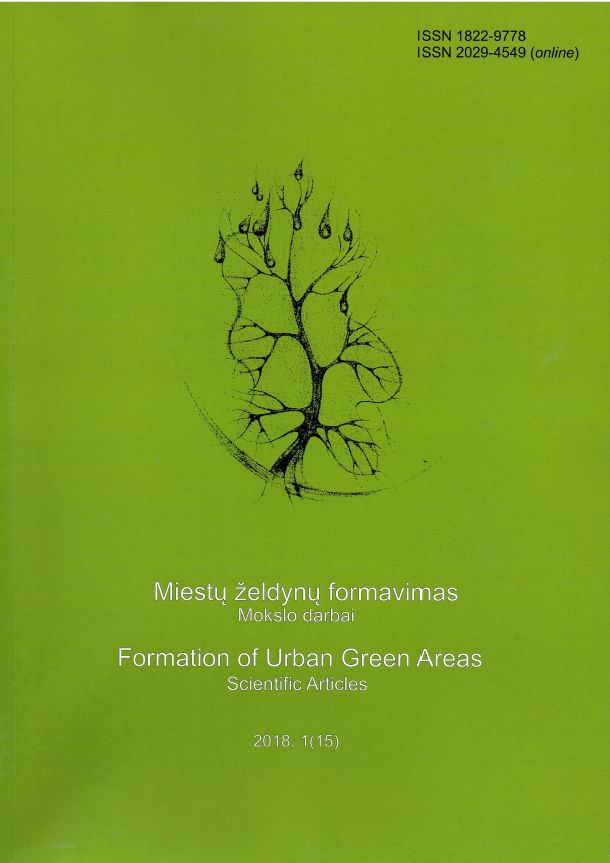Revitalization of Degraded Urban Space of the Town in the Context of Biologically Active Space – the Architect's Points of View
Raktažodžiai:
transformation, revitalization of the degraded urban spaces, biologically active spaceSantrauka
Greenery is an important element of urban content. Its importance was noticed and taken into account during the implementation of many urban revitalization projects around the world. The revitalization of degraded areas through the revival of their by greenery is not only consistent with the policy of sustainable development, but is a contribution to the revival of public space, thus raising its value on the socio-economic level.
Urban areas are degraded mainly due to the natural effect of industrial restructuring in all countries. Economic transformations have left the European countries with a heavy burden of degraded areas and with the weakened market capacity to 'recycle' them and use them for other purposes. Revitalization of these areas is important for local development, but also refers to social and environmental issues, especially in regions with high unemployment rates. This situation is a serious problem that affects the competitiveness of cities. Degraded areas have not only a negative impact on the image of a given space, but also become a good place for the development of negative social phenomena, in extreme cases even criminogenic. The balance of a complex, multi-layered system that is public space is shaken in such circumstances.
Through skillfully conducted comprehensive analyzes, architects acquire knowledge allowing them to propose a revitalization project that, by showing the values of a given place, is able to convince the investor to become interested in a given space and to heal the urban tissue.
Investors should be offered a solution that reconciles their requirements with the needs of the local community. The solution corresponds with the whole urban layout, smoothly cooperating with it and fits into the socio-historical-cultural context. New urban quality should be proposed as a response to the existing situation.
In the case of revitalization with greenery, a large part of the concepts presented by architects has a significant impact on changing the perception of a certain urban space, its character and quality of life of people living in the area. Most often in cases of post-industrial areas, they change their character significantly through the introduction of greenery and enter into a dialogue with the past of the place.
The very attempt to define, let alone create ideal living conditions, is not an easy task. Such a place should provide not only safe and comfortable living conditions, but also create a common space, allowing for the creation and strengthening of social ties, conducive to the emergence of a sense of local identity, but also friendly to outsiders. The city, which is revitalized with green areas, is able to approach the above-mentioned ideals due to the softening value of greenery and the possibility of creating zones affecting positively the well-being of people and the socialization of residents.
The following study contains examples of various attempts to heal degraded spaces, using the resources of green areas.
Nuorodos
Czyżewski, A. (2009). Trzewia Lewiatana: miasta ogrody i narodziny przedmieścia kulturalnego. Warszawa: Państwowe Muzeum Etnograficzne.
Eindhoven Strijp-S, 7–8 may. (2006). Internet link: http://www.iiinstitute.nl/studycases/sc-eindhoven-strijp-s
Frantz, J., Hanke, S., Krampen M. and Schempp, D. (2000). Ogród zimowy: Bliżej natury: przykłady projektów architektonicznych i rozmieszczenia roślin. Warszawa: Arkady.
Jackiewicz, W. (2004). Architektura organiczna a modernizm. Wrocław: [Wiktor Jackiewicz].
Ryńska, E. D. (2001). Bioklimatyka a forma architektoniczna. Warszawa: Oficyna Wydawnicza Politechniki Warszawskiej.
Superkilen / Topotek 1 + BIG Architects + Superflex, 25 October. (2012). Internet link: https://www.archdaily.com/286223/superkilen-topotek-1-big-architects-superflex/5088d8fc28ba0d757100010c-superkilen-topotek-1-big-architects-superflex-image
Szparkowski, Z. (1999). Architektura współczesnej fabryki. Warszawa: Oficyna Wydawnicza Politechniki Warszawskiej.
The Rehabilitation of the Zsolnay Factory. (2011). Internet link: http://www.landezine.com/index.php/2015/07/the-rehabilitation-of-the-zsolnay-factory-by-ujirany-new-directions-landscape-architects/
Triangle Strijp S, Eindhoven, ano 12, set. (2012). Internet link: http://www.vitruvius.com.br/media/images/magazines/grid_12/93de1e5a24cf_img_018.jpg
TURI: Parco Dora, Turin, IT. (n.d.). Internet link:: http://www.latzundpartner.de/en/projekte/postindustrielle-landschaften/parco-dora-turin-it/
Wejchert, K. (2010). Elementy kompozycji urbanistycznej. Warszawa: Arkady.


